Closed backs kinda suck.
It’s no secret that the current-production dynamic driver closed back market doesn’t provide many well-rounded options. When it comes to choices that are even worth their asking price, there’s basically six or seven from $50 all the way up to flagship level: Creative Aurvana Live! SE, AKG K371, EMU Teak, Aurorus Australis, and arguably Focal Stellia. Even though these headphones might have one or two things that make them an easy enough recommendation, not all of them are as well-rounded a product as I’d like.
I enjoy the experience a good closed back can provide. With the advent of K371 in recent years, the budget market has had at least one competent provider of this experience for most people. While K371 is a revolutionary example of how you don’t have to pay thousands for good frequency response tuning, even the K371 has compromises that leave the budget market without a truly decisive recommendation, absent caveats or asterisks (which in K371’s case are build, comfort, and technical performance).

The dynamic driver closed back headphone landscape, littered with compromises top to bottom, has recently been shaken up a bit with the release of RØDE NTH-100, a closed back dynamic driver over-ear headphone retailing for only $150.
RØDE is an Australian company best known for their microphones, and my experiences with their products have ranged from painless to pleasant. The newest revision of the RØDE NT1 microphone, for example, is a particularly good choice for those in the budget recording landscape, as it’s only $270USD but features a relatively neutral sound, solid build and accessories, and an extremely low self-noise relative to most other microphones in its class.
While the NTH-100 has its problems, I ultimately find that it has a similar price/performance ratio to the NT1, which was in itself a benchmark in the budget recording space upon release, though NTH-100 is given a slight handicap due to its low price and how few serviceable options there are in its particular market segment.
Let’s start the review in earnest with something I don’t usually talk about, something that’s a unique enough aspect of the offering here that I think it’s prudent to spend significant time on it.
Build and Comfort
The NTH-100’s build seems, upon initial testing, to be significantly more robust than most of its competition. Its comfort at minimum bests most of its immediate competition handily.
The earpads are triangular, made of memory foam covered in Alcantara, with a layer of cooling gel sandwiched between the foam. This is one of the QoL features I didn’t expect to even care about (let alone notice), but every time I put them on, the first 15 or so minutes are always noticeably cool. While initially it seemed like a very random and likely forgettable feature, it’s proven to be a welcome one that I enjoy being reminded of every time I put it on.
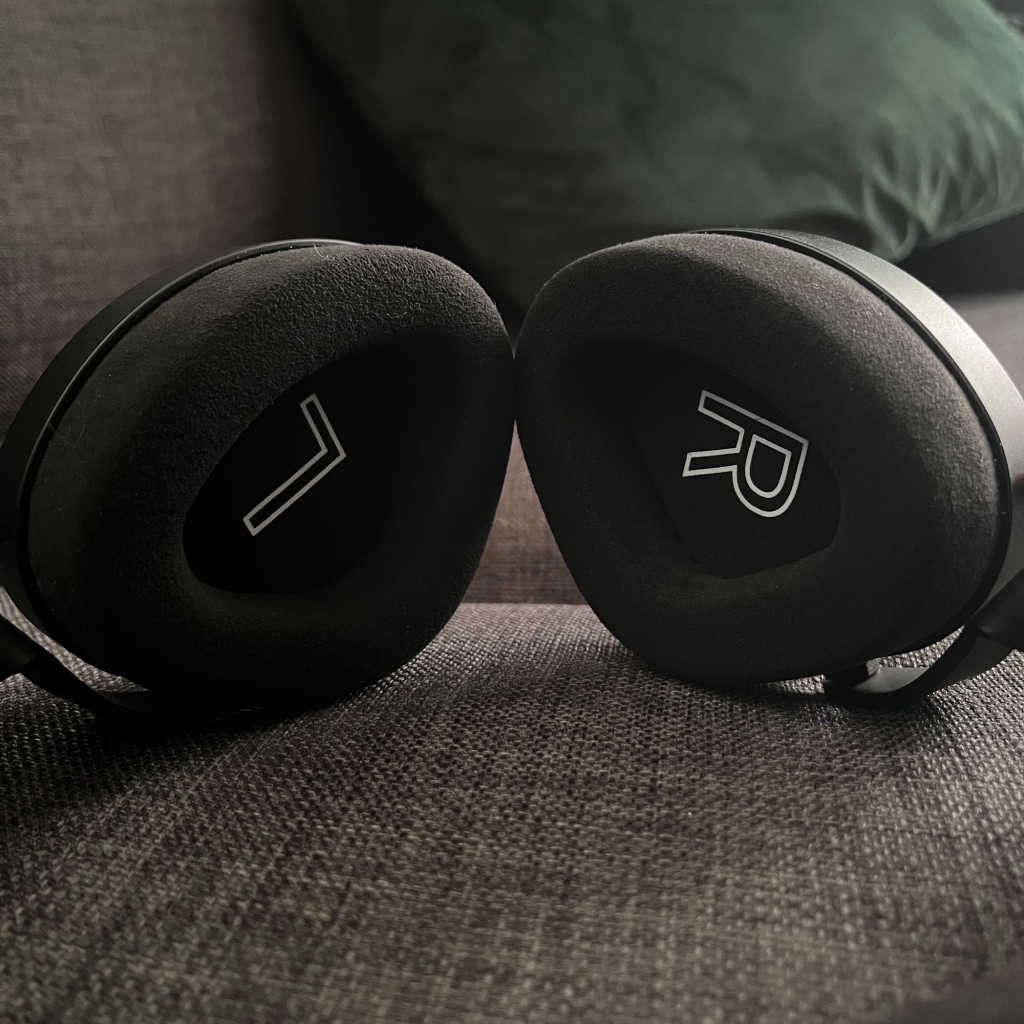
The pad circumference is definitely on the smaller side, so unfortunately they won’t fit everyone, but for my ears the pads are perfectly sized and deep/firm enough that my ear never touches the inner baffle, especially because the inward clamp force/caliper pressure is pretty much right down the middle between loose and tight (on my small-ish head). They’re looser than a fresh HD600, but tighter than Denon/Fostex closed back. Isolation is not the best, admittedly. It seems to be less isolating than K371 across the board, so if you really need top-tier passive isolation, I’d say look elsewhere.
Also worth noting is that the pads are easily removable by the end user, fastened to the cup with a locking clip system reminiscent of the Focal or Sennheiser 6×0 series headphones. Pull to remove, fit back on and press/click to fasten. Now we just wait to see if they introduce a SKU for public purchase so we can replace pads in the future if we need to.
The headband pad is likely the weakest part of the comfort equation, as it’s similarly covered in Alcantara, but filled with a less firm/supple padding material than I’d have liked. I find I still get a hotspot in long sessions, possibly because the headphone itself is somewhat heavy (~350g) compared to something like an HD600, though in isolation I’d never really call NTH-100 a “heavy” headphone. I’d have liked a suspension strap, but it’s still a more comfortable headband than the other non-suspension strap models in the closed back space.
The detent-less locking headband extenders are another laudable design choice, at least in theory, that I never knew I wanted or needed. The extenders are metal, likely spring steel or aluminum, and they sport a unique clickless sliding adjustment that you can lock in place with a knob. The decision to avoid detents is actually a smart one, as I find in less expensive headphones, whether it’s AKG K371 or even in mid-fi stuff like Hifiman Sundara, the detents are one of the first parts to show significant wear and they’re a pain to live with when they wear completely.
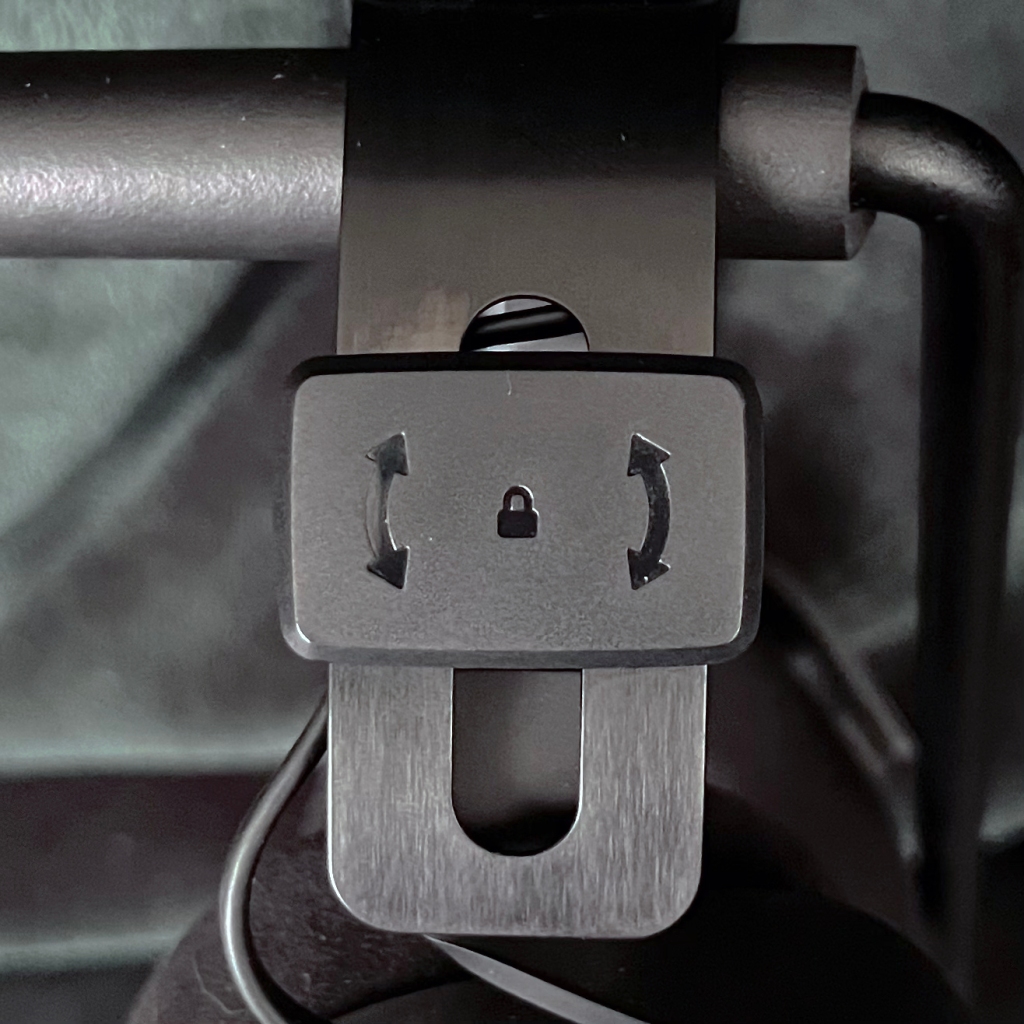
The aforementioned adjustment lock has proven to be convenient and painless to use. I found my ideal height within the first day and haven’t touched the height adjustment since. This is yet another feature I thought would be met with apathy—or worse, annoyance—but it has, like the cooling gel, actually proven to be very nice to have.
However, it's worth noting that since the release of these headphones, many users have had complaints of the adjustment lock on their headphone breaking, rendering the headphone useless. A word of caution to potential buyers.
The finishing is mostly matte black, save for a glossy etched Ø on the sides of the cups. Aesthetically, I find it to be a lovely, if industrial looking pair of headphones both on a stand and on my head, certainly better looking than K371… but it’d be better if it didn’t have the Ø on the cup.
One last thing of note re: design is that the NTH-100 can be connected via single entry on either earcup. This is a feature I last remember seeing on the V-Moda headphones back in the day, and it’s a welcome addition, but RØDE went a step further than I think anyone would reasonably expect them to on their first headphone and included a rubber plug to seal the unused side so that you don’t get channel imbalance. When the hole is plugged, channel balance is spot on, to my ear.
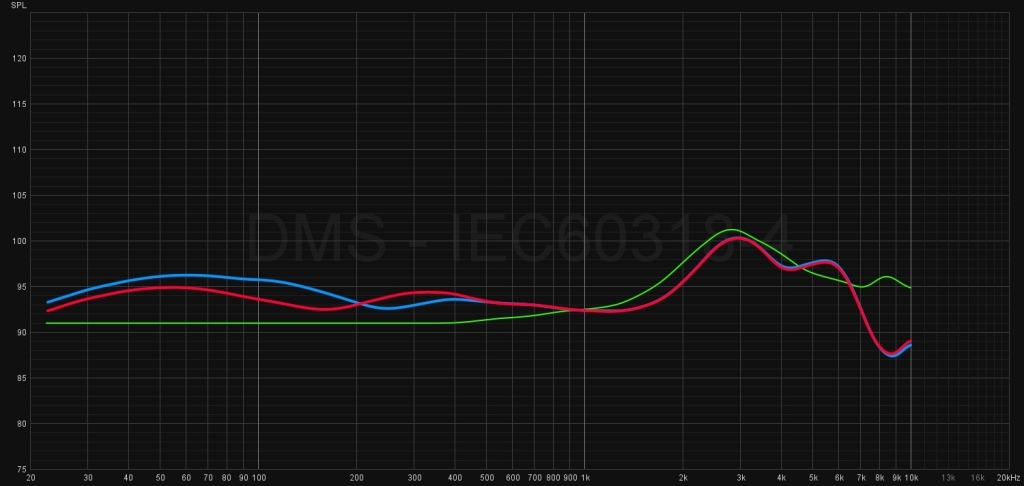
Interestingly, upon inspection you can see that the plug has a small vent hole in it. If you plug the hole of the open side, and you cover the vent hole with a finger, the bass suddenly gets quieter on that side. This means not only did they make sure both sides would be sealed, but they made sure that both sides would be equally sealed.
Reconciling this with all of the other surprisingly well-conceived design features present in NTH-100, and you have a headphone that is uniquely comfortable, painless to use, and preternaturally sturdy feeling. I’ve only had them for a few days, but I get the sense that these will last a long, long time.
It’s main competition sonically is AKG K371, and in this arena the fight is tough, no doubt. In the realm of build and comfort however, there is no contest. The NTH-100 clobbers it and pretty much everything else in the closed back dynamic market in this price range.
Final Note on QC
One more thing worthy of note after revisiting this review with the benefit of hindsight, is that I've noticed my impressions of the frequency response don't precisely correlate to the graphs generously provided by Resolve and DMS. In comparison to my K371, along with testing rigorously with sine sweeps, I found that my pair sounds approximately like the green line on the following graph when on my head.
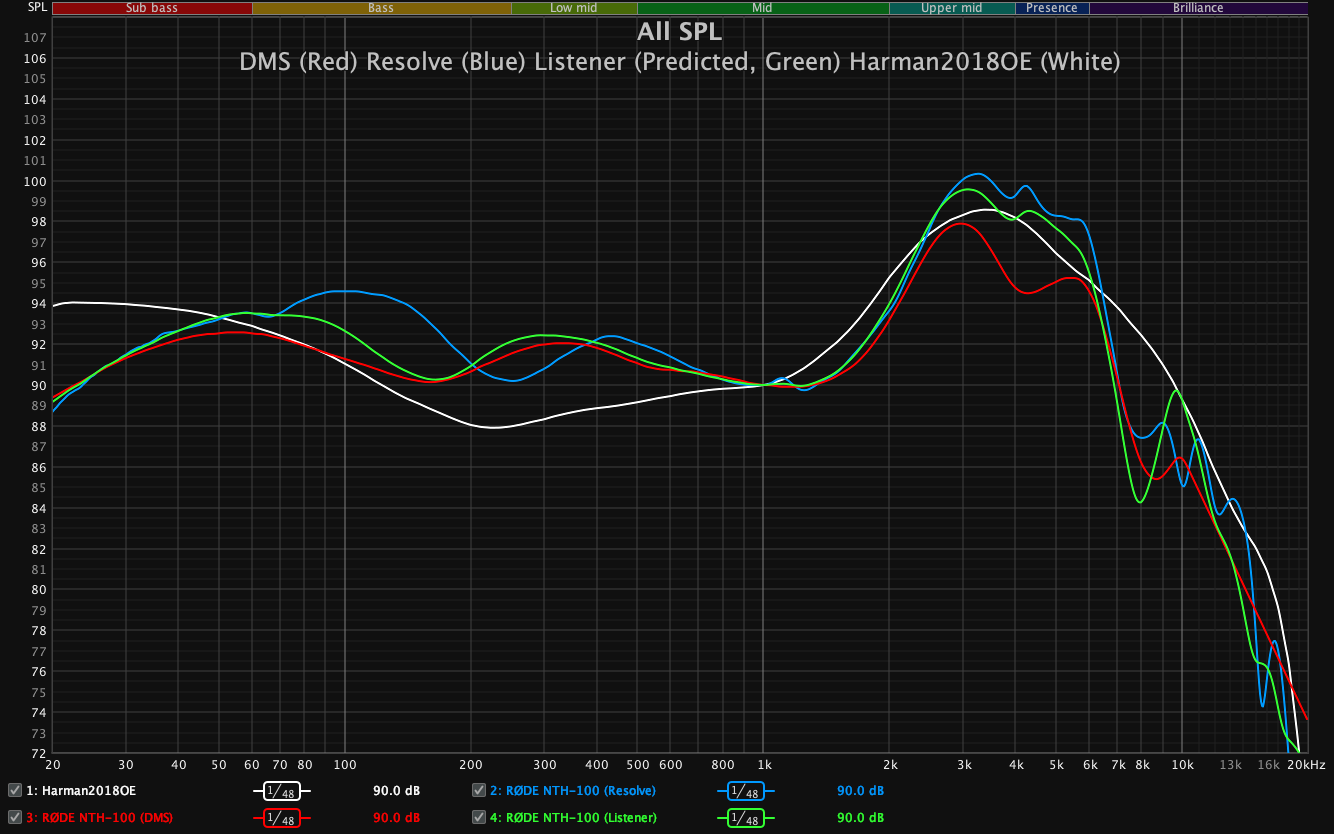
Unfortunately this means there is one more significant QC problem here in addition to the build issue of the locking headband mechanism. The lack of FR consistency between units, as well as the high THD remarked by Resolve from Headphones.com, means NTH-100 will likely be a poor candidate for EQ for most users, as it will prove difficult for most end-users to discern whether or not their unit aligns with the available graphs of NTH-100. They will have to EQ by ear... which is doable, just not as nearly as easy.
With all of that being said, a headphone is not solely judged on its build and comfort. What do these sound like, regardless of these factors? How do they measure up against their competition?
Frequency Response and Tonality
NTH-100 deviates significantly enough from the standards of consumer preference and ”neutrality” we compare headphones against that i’d have no trouble calling it a “colored” headphone.
Whether or not this coloration is preferential to you is ultimately based on a few factors like taste, music library/program material, HRTF, etc. As such, I think it’s worthwhile to tell you a bit about how those things factor into my assessment:
My HRTF hates me. I’m incredibly sensitive to mid-treble (8-12kHz), to the point where even something like Sennheiser HD650 tends to be grating to me at times. As such, I tend to prefer headphones with a dark treble response, with Aurorus’ Borealis and Australis being my favorite treble presentations on the whole for this particular aspect.
The music I listen to tends to be mostly modern. Pop, R&B, hip hop, jazz and its modern offshoots, classical, punk, rock, alternative, etc. They all play significant parts in my listening/testing, so the full frequency spectrum from sub-bass up to high treble is tokened fairly often.
The things I index heaviest for tend to be a sense of subjective tonal/timbral realism and dynamic punch. I want my music to sound as bereft a sense of artifice as possible, while also having a sense of tactile impact and slam. Things like perfect adherence to a frequency response target, detail/resolution, imaging/soundstage, etc. have never mattered to me quite as much as they seem to matter to others.
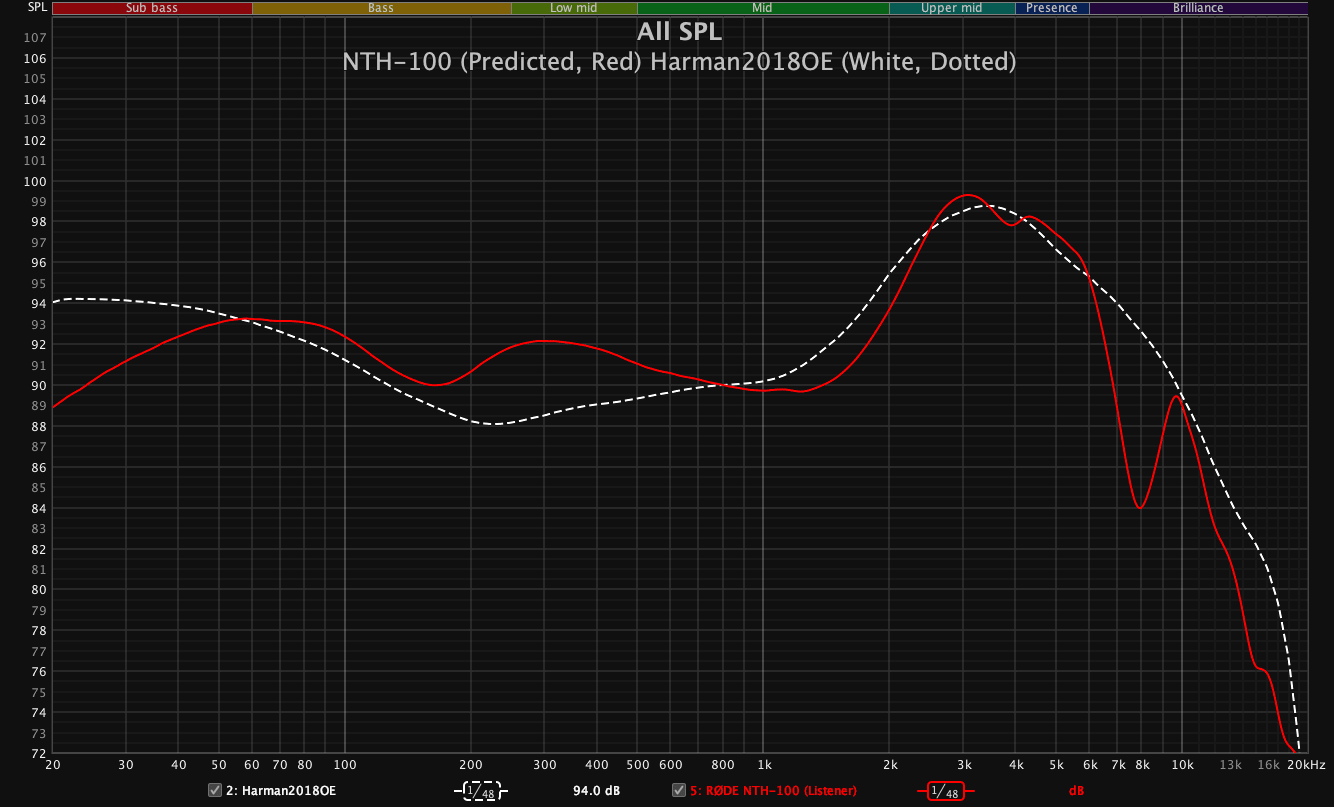
Bass
This tuning prioritizes mid-bass and the low-midrange, while avoiding either stepping into territory I’d call overbearing. While there were a few times the mid-bass became resonant enough to be make fundamentals or early harmonics of bass instruments become bothersome (I usually have a low tolerance for this kind of overly-sonorous behavior), it didn’t bother me nearly as many times as I would’ve thought given the rest of the tuning.
Bass here lacks a certain element of largesse that its competition like K371—with its sub-bass extension/boost—offers, though personally K371’s bass has always bothered me because things tend to have size, but lack mass/density.
What NTH-100 lacks in size it makes up for in warmth, density, and texture, where unlike K371 it presents a rich, if slightly over-warmed, presentation for most bass instruments and drums. The primary bass in Radiohead’s All I Need, a song I have used for testing bass for about 10 years now, lacks a monolithic hugeness that transducers with more sub-bass provide, but NTH-100 retains the sense of rich texture in the low-midrange that I love while presenting things overall as a little more small.
That being said, while I find the approach here enjoyable, it’s not refined as well as I’d have liked. I wish the mid-bass elevation was shifted slightly lower in frequency to maybe avoid some of that resonance that results from most tracks having the bulk of their bass energy focused in the mid-bass.
The bright side here is that the bass doesn’t bleed into the 150-200Hz upper-bass area without contour, so kick drums aren’t overly chesty or boxy, bass isn’t overall tilted too much in favor of its primary harmonics, and male vocals have a nice weight to them without sounding cloudy or occluded.
Low Midrange
Many closed back headphones will have a dip somewhere between 100-400Hz. How and where the designers choose to tune this oft-found dip ends up being a big part of how a closed back headphone sounds overall, since it’s in an area where instrumental/vocal fundamentals lie.
Many closed backs in NTH-100’s price range/target use-case, like Beyerdynamic DT770, Shure SRH440, Sony MDR-V6 for example, seem to have a similar peak-into-dip behavior right around 200Hz.
Even more expensive audiophile offerings like the Meze Liric, Sennheiser HD820, and Focal Stellia exhibit a similar behavior.
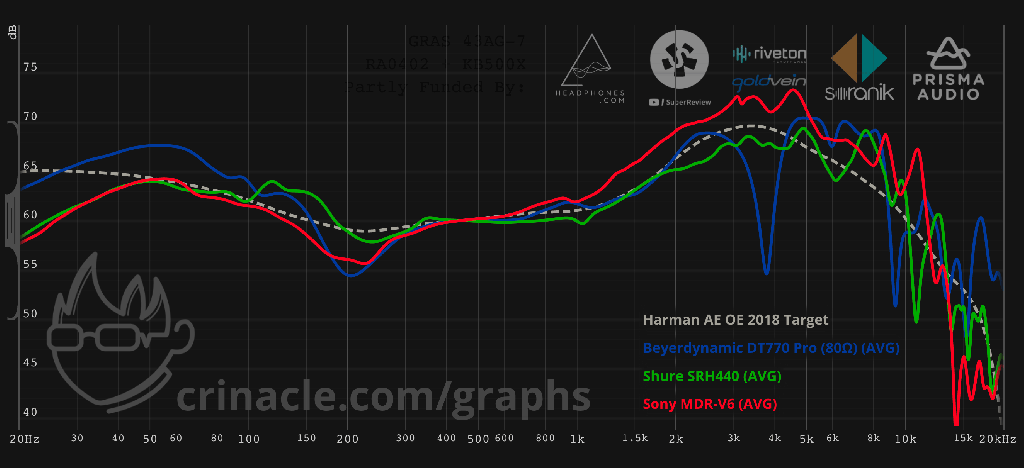
This gives most of these types of headphones a thinness in their midrange which is clear at best, harsh at worst. Even when this dip is integrated well with what’s above it, it usually causes more contrast with the bass below it. In most closed backs, I find this behavior reminds me of a bad crossovers in consumer grade 2.1 systems.
What the NTH-100 seems to do differently than its contemporaries is elevating the areas both directly below and above this dip at ~180Hz, while keeping the whole range (including the dip) boosted above what i’d call ”neutral” for this area. The magnitude of the dip isn’t super distinct or steep, but it’s enough to give adequate contrast between bass and low-midrange while never sounding anywhere near ”thin.”.
The subsequent elevation around 300Hz lends a sense of fullness and note-weight to the fundamentals of higher pitched things like female vocals, horns, flutes, and the higher octaves of string instruments, as well as the more throaty harmonics of bass. On Caroline Polachek’s So Hot You’re Hurting My Feelings, Polachek’s vocal acrobatics take her voice all over her vocal range, and when she reaches the top and goes into head-voice/falsetto, the vocal doesn’t thin out at all, while on headphones with a more “neutral” tuning like K371, female vocals reaching this part of their range tend to bias too much towards the harmonics and leave the voice feeling thin and sometimes even strident.
This ~300Hz bloom would be sorely missed (and is missing from the above mentioned closed backs) if it were absent. If there were no dip at all here, and amplitude fell gradually from 100Hz to where it sits at 300Hz, NTH-100 would likely step decisively over the line from “warm” into “bloated/muddy” territory. If it had the dip without the rise at 300Hz, it would be too thin.
Center and Upper Midrange
Pretty much all voices and instruments will have energy here, and this is where the impression of a downslope is likely to be potentially problematic for some listeners. Vocals sound somewhat less intense and intimate than many might prefer. Bass instruments are balanced away from its denser, scratchier high harmonics & towards its more “toneful” or “grunty” lower harmonics. On things like bowed cello, for example, I find this coloration to be excellent at conveying a surprisingly rich sense of texture without any over-sharpening or thinness.
While guitars have a little more size to them than normal, they unfortunately also have less richness and overtone density to them. The dip around 180Hz helps to stop guitars from ever getting too bloated or muddy despite the overall downslope, but only just.
The guitars in Third Eye Blind’s Graduate sound a little too scooped, leaving you with more of the low-end cabinet resonance and fizzy high end, while de-emphasizing the beautifully complex midrange harmonics. Snares and kick drums lack a sense of midrange “bark” and forwardness, for sure, which is probably gonna be one of the things people pick up on pretty quickly.

Luckily, aside from the recession between 1-2kHz, upper midrange here (specifically the pinna gain elevation) is pretty much exactly where many tend to prefer it, and as a result, the warmth of the downsloping low/center midrange is balanced out very well with the clarity here.
That all being said, the main plus for NTH-100 is the way vocal midrange is presented overall is surprisingly unproblematic and comfortable sounding. They are biased towards their fundamentals at most times which makes things sound full and free of stridence, while never really being dark or swollen.
Overall, it’s definitely not a neutral midrange, but it’s also not necessarily a deal breaker, especially for those acquainted with this kind of coloration and what consequences it might have for certain technical aspects (more on that later) or how it would jell with their personal taste.
Treble
As I’ve mentioned in my glowing review of the Aurorus Australis, I really enjoy and prefer when a headphone has a recessed mid/upper treble. It’s both incredibly rare to find in the audiophile space, and hard to do without robbing the sound of a sense of overall clarity. And yes, NTH-100 might not be the most detailed or “clear” treble presentation, but the tuning here makes treble easy to listen to and particularly non-fatiguing for me, which I will always choose over something that is hyper-detailed but equally fatiguing.
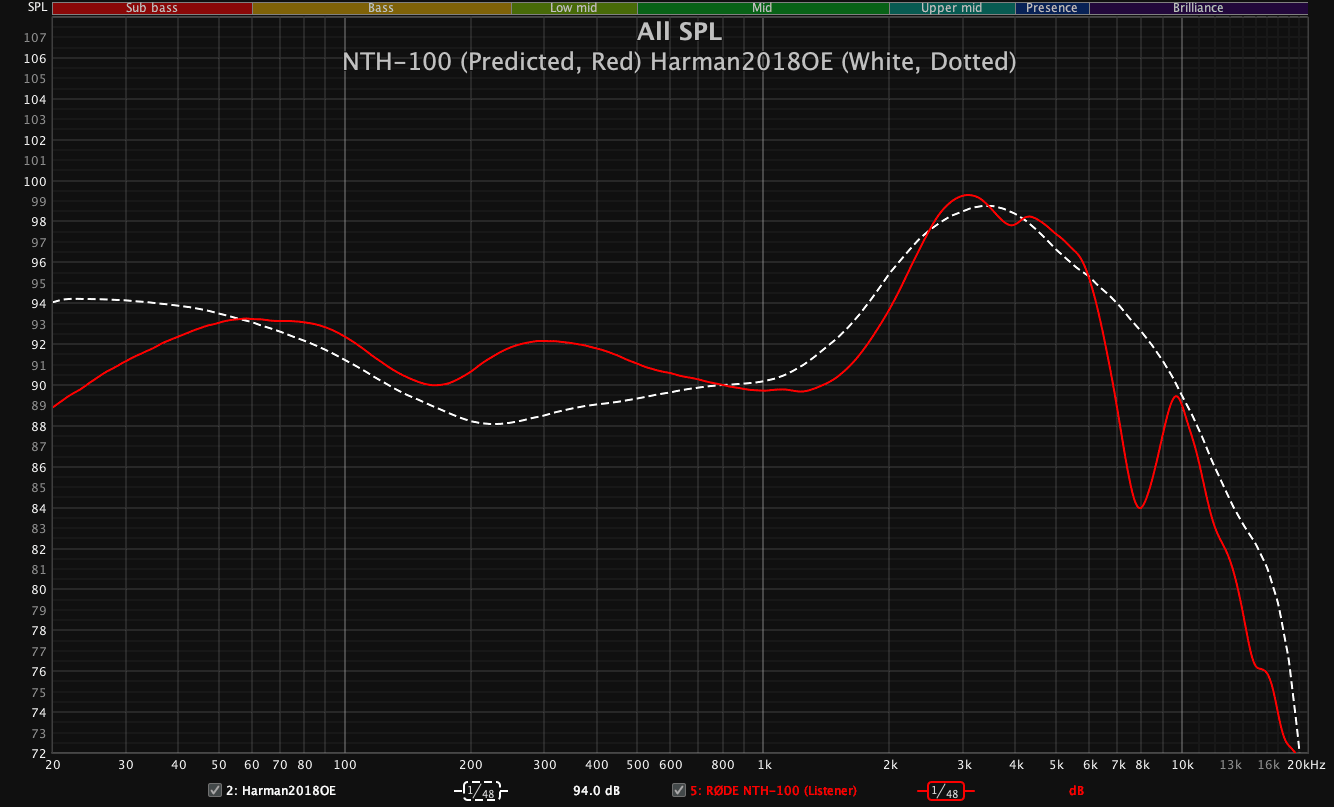
The lower treble emphasis between 4-6kHz (compared to my personal target) can make the upper character of vocals a little too papery at times, but never to the point of being unlistenable. The top end of electric guitars is sometimes too crispy, especially on tracks where distortion is part of the equation. The crack of a snare drum is sometimes a little too crunchy. But in the game of compromises that is over-ear headphones, this kind of treble tuning, biasing towards the lower-treble vs. the mid or upper treble, is ultimately what I prefer vs. the alternative. Despite the overall recessed mid and upper treble on NTH-100, tracks like Morning by Beck which have a V-shaped acoustic guitar at the centre of its arrangement still have enough clarity of treble character to not sound entirely rolled off to me, and I'm happy living with that.
Summary
As far as how I’d sum up the coloration overall, I’d probably call it simply “warm-tilted”, because I find NTH-100 isn’t downsloping overall quite enough to be “dark.” Its upper midrange still has a competent clarity to balance out the bass/low-midrange emphasis, and the lower treble does enough to make things never step over the line into complete mud-fi.
I find NTH-100 to be a cozier, thicker listen than most of the other audiophile closed backs I’m used to, and that comfortable quality makes it enjoyable enough to say the tuning here is among the more well-integrated for warm tunings I’ve heard. The pieces at play here all fit together quite nicely and in my opinion, it coheres better than even K371, which in comparison sounds much more disjointed between its massive sub-bass, scooped mid-bass, comparatively lean midrange, and forward mid-treble.
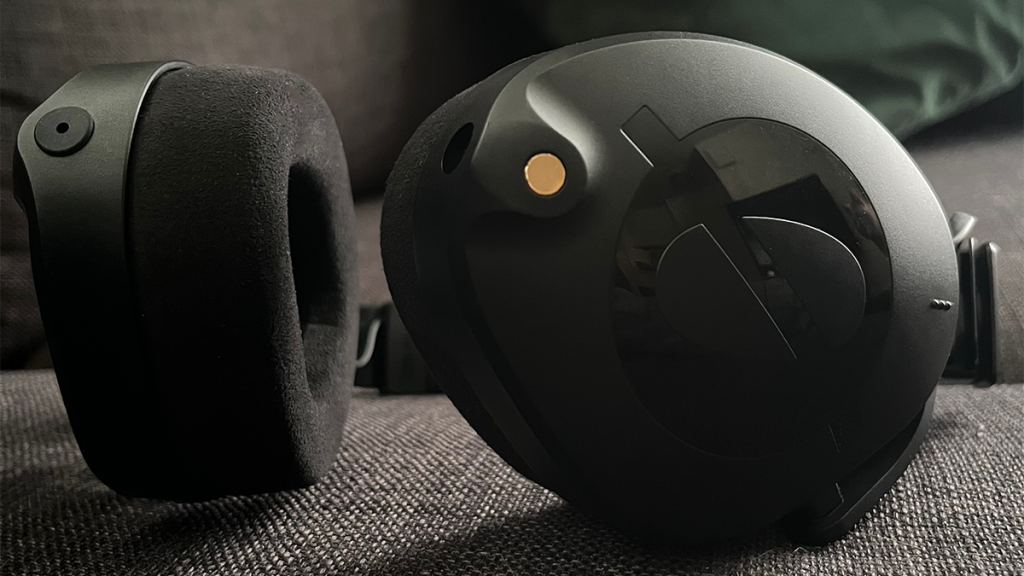
Detail, Resolution, Texture
Now that we’ve moved on to technical performance, I feel it’s necessary to say that the NTH-100, specifically the front volume, is very heavily damped. The front of the driver is covered in a thick felt pad, which is glued to the baffle, and underneath the felt the baffle is surrounded by a silk/nylon material similar to Sennheiser’s old “black silk” damping material.
While this absolutely has an effect on the tonality, it’s likely also responsible for what is ultimately a mixed bag regarding technical performance on the whole with NTH-100.
NTH-100 is a less detailed headphone than AKG K371 (its main competition in this price bracket). This should come as no surprise given the delta in tuning between the two; K371 is tuned more towards overall tonal clarity, and as such, small cues are much more present and discernable with the K371.
I find when it comes to the nuance within those little details, and overall textural resolve, the two are closer to being on equal footing. K371 still gets the edge in the high frequencies, where texture overall is more easily discernible. NTH-100, on the other hand, takes the win for resolution and texture in the lower end of the audible band (bass and low-midrange), where it has a better sense of richness despite overall not being as textured as things higher up the price bracket like EMU Teak.
Dynamics
Considering how much front-damping was implemented on NTH-100, I was surprised to find that the sense of slam is actually better on NTH-100 than on the K371. The latter has a relative mid-bass de-emphasis which can make kick drums lacking in their sense of tactile thump, especially paired with its sub-bass emphasis which, as mentioned previously, adds a dissonant sense of elements being large, but lacking density and mass. Comparatively, NTH-100 is much better at providing this sense of heft in its initial impact, likely due to its different approach to tuning.
That being said, due to NTH-100s significant damping, I find that the decay is truncated enough to be immediately problematic. In terms of microdynamics and envelope integrity, especially in the treble, NTH-100 flat-out underperforms vs a lot of its competition. Treble elements sound unnaturally quick in how steeply they trail off and disappear. Minute volume changes seem to get rolled into one another quite messily, and as such the sense of groove offered by this headphone is greatly (but not solely) reliant on whatever rhythmic elements the program material offers in its bass and midrange.
Thankfully, the midrange of NTH-100 is significantly better at this aspect than the treble, where things sound competently natural and unencumbered when presenting the long decay of a vocal reverb or the natural bloom of an acoustic guitar. It’s still shorter in decay than what I’d consider natural, but it’s at least noticeably more ”normal” than the treble.
The bass microdynamics are competent enough for a closed back in this range, but once again, only just. On the small interstitial plucks of an electric bass in D’Angelo’s 1000 Deaths, you can feel NTH-100 struggling to keep up and portray each note’s individual pluck as an entity separate from the unyielding gallop of the kick drum.
In comparison, K371 seems to struggle with this aspect similarly, and perhaps stumbles even more (possibly due to its sub-bass being overly dominant and occluding the changes in the mid and upper bass), so while neither really does great here, I don’t know that any closed back in this price range really does.
In the realm of overall macrodynamics, I find NTH-100 and K371 to be trading blows. K371 does better at conveying timbral dynamics; instruments going from quiet to loud are portrayed as more accurately ramping up in timbral intensity to match, which affects the sense of how drastic these changes feel. NTH-100 on the other hand isn’t quite as diverse in its timbral range, where it causes things to sound kind of muted, even as they’re supposed to be getting more intense.
However, the NTH-100 does a better job at capturing the range of pure amplitude of the volume swings present in these macrodynamic moments, and the feeling of mass moving in these moments is overall more palpable.
Soundstage and Imaging
The readers with a little more experience in this hobby might’ve caught on when I mentioned earlier how the center/upper mid recession would have consequences for certain technical aspects. To those experienced readers, by now it should be clear that I was referring to how such a recession often has consequences for our perception of soundstage, and that certainly seems to be the case here.
While it’s obviously nowhere near HD800, any open back headphone, or even on par with the particularly spacious closed backs I’ve tried like the Australis and Verité Closed, NTH-100 has a presentation of soundstage surprisingly free of the pitfalls of most closed backs, namely disjointed front imaging and feeling uncomfortably “in your head.”
NTH-100 stages wider and less 3-blob than K371, with a marginally better distribution across the front-stage. Importantly though, the center image is much less annoyingly close than K371’s center image is. It gets pulled out front just enough to free you of the sense of intrusive intimacy that K371 has, but not enough to sound like you’re listening to something like a well-staging open back.
Overall the soundstage is pleasantly free of claustrophobia, and in a closed back for $150, I think this might be the most interesting aspect of the technical performance, since I don’t think any closed back even somewhat near this price range has a stage as minimally problematic.
That being said, the imaging here is… not good. If every instrument is an image within the stage, the edges of those images on NTH-100 are blurry and indistinct pretty much as a rule. They almost reach the point of blending together significantly in busy passages or tracks where two instruments are panned closely to one another. In general, you don’t get much separation or air between the elements of the mix on NTH-100, likely due to the lack of treble overall.
While the image clarity really isn’t great here, the sense of localization for these sounds is what I’d call competent. I can make out small gradations of panning just fine, or at least as well as the other closed backs it competes with.
Timbre
This is usually the hardest section to write about. Because definitions of timbre vary so wildly, and in this case because I’m comparing these heavily to K371, I find myself unable to fence sit and having to pick a side.
Many enthusiasts define timbre as the ability to discern between different instruments based on their individual formants (in other words, the unique shape of their harmonics). For this definition of timbre, I don’t think it’s a surprise that K371 bests NTH-100.
K371 is a more neutral headphone, and on K371, pretty much every instrument tends to be easier to pick apart and ascribe to its real-world counterpart; K371 homogenizes instrument identity less than the RØDEs do.
NTH-100 has a tendency to compress the distribution of “types” of sound into all leaning similarly warm, laid-back, or inoffensive. This homogenization can be a detriment to a lot of people who fold that aspect into timbre (or detail/resolution, for that matter).
However, to me, the NTH-100 easily bests K371 at sounding subjectively pleasing and unproblematic to me. I think it’s that the thicker, less artificial, less “cold” and claustrophobic presentation is more preferential to me. NTH-100 is tuned for comfort and tilted in favor of warmth, while K371 sounds thin, mechanical, and disjointed by comparison.
There’s just something about NTH-100 that makes it sound so much less annoying than the K371 on basically any music I throw at it, even taking into consideration that the presentation of decay isn’t really great either due to the significant front volume damping.
This is where the audiophool in me rears its ugly head. Is the K371 more neutral? Yes. Does that mean that extrapolation of instrument identity is easier? Yes. Does that mean K371 sounds more natural or real to me? No, not really.
NTH-100 forces me to reconsider what my definition of timbre really is.
It gives me an experience way less likely to aggravate the least forgiving parts of my HRTF, is less disjointed in the critically important bass-midrange transition, and leaves me feeling less of a barrier between the music and I. It's not necessarily that NTH-100 is more real-sounding, but that my music is asking nothing of me except to enjoy, instead of begging me to unpack, analyze, and critique it.
NTH-100 sounds smooth, but not completely dead/limp. Warm, but not boomy or 100% dull. Slightly dark, but never completely occluded. This is what some may call a “romantic” timbral experience, but personally it just sounds better to me.
The best analogy I can think of is: if you’re the type of person to enjoy HD650, I can’t help thinking that there’s going to be a 50/50 chance that you’ll find NTH-100 more enjoyable than K371, as weird as it may sound.
Conclusion
So what are we left with here?
By my estimation, you get a closed back with a reasonably well-integrated warm tuning that avoids some all-too-common “closed back pitfalls,” like midrange thinness, claustrophobic or non-existent soundstage, one-note texturing, all while only costing $150 and sporting a build and comfort that is, surprisingly, good.
But do I recommend you buy NTH-100?
Probably not, to be honest.
The fact is: If you’re shopping in this price range for a wired closed back headphone without a mic, you are more likely than not one of 3 types of consumer:
- Someone looking for a studio headphone for professional or prosumer use.
- A new and/or burgeoning audiophile shopping on a relatively small budget looking for a good closed back headphone.
- A seasoned audiophile, bored, thinking about YOLOing a cheap closed back in hopes that it actually does compete with K371, because... hey, that’d be pretty cool.
If you are 1 or 2, which to be honest, I think most people thinking of buying these will be… you should probably still buy the K371.
The studio/pro audio people either need isolation, a neutral reference for midrange, or both… and for those things, NTH-100 just isn’t as good as K371 is.
If you’re completely new to the audiophile space or still exploring it in the early-ish stages and looking for a closed back headphone, I still think K371 is not only the easy choice, but possibly one of the most important headphones in the modern era for this hobby. You should probably buy it above most other things, so you have a barometer for what the Harman curve actually sounds like, a sound against which you’ll likely be comparing other headphones as you continue to navigate the hobby.
If you are type number three… well then the answer gets a little more complicated.
NTH-100 really isn’t technically exceptional, and it has a tonality that deviates pretty significantly from our established targets for consumer preference. Nothing about it is really what I’d call a “safe buy” for someone who doesn’t know their preferences...
But if you’re one of the seasoned audiophiles who does know they like warm headphones, doesn’t like K371, has a really upsetting HRTF like me, or just wants to try out a unique closed back tuning, the NTH-100 has made me surprisingly happy in my short time with them, and I’m excited to own them for the foreseeable future.
I won’t lie… I had high hopes for NTH-100. While it didn’t really live up to my hopes of being a more technical alternative to K371, it exceeded my expectations when it came to build and comfort, while offering what is IMO a viable alternative tonal/technical flavor to K371, and it just so happens that NTH-100 is something I prefer pretty much across the board.
After all, just because it didn’t entirely, irrevocably change the landscape of this market segment overnight and become “the new indisputable king” for everyone, that doesn’t mean it’s not a compelling and valuable option.
Who needs kings anyway?
-listener
Comments?
Leave us your opinion.